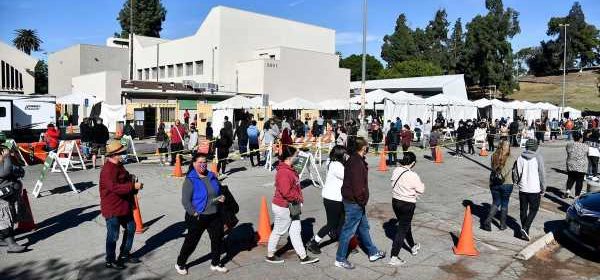California Sees Upbeat Budget Cushioned by $15 Billion Surplus

California Governor Gavin Newsom on Friday unveiled a $164.5 billion budget for the next fiscal year, detailing how he plans to spend a $15 billion surplus that the state has accumulated despite the pandemic-induced recession that’s left thousands of businesses shuttered and1.5 million people still out of work.
Besides his already announced plans to allocate grants for small businesses, send $600 checks to low-income Californians, and help schools re-open more quickly, Newsom said the budget will spend a record amount for public education, dedicate $4.5 billion to help the state’s economy recover and pay down almost $10 billion in long-term liabilities. He said various savings accounts will total $22 billion, a record high. Cuts in state worker compensation may not be necessary, acccording to the budget.
“California is not only poised for recovery, but we’re seeing real signs of recovery in our state,” he said in a briefing in Sacramento.
The unexpected windfall, which a budget watchdog had previously predicted could be as large as $26 billion, is largely due to tax collections from the state’s wealthiest residents, who have reaped the benefits of rising stock prices and stable employment even lower-income workers lost their jobs in the pandemic. At the same time, impending Democratic control of the U.S. Senate has increased chances of additional federal aid to California and other local governments.
“The state is in much better financial condition to avoid the very large cuts that they’ve had to do in the past that cut significant services right when California residents needed it the most,” said Dora Lee, director of research at Belle Haven Investments, before Newsom’s presentation. “The California budget is in some ways a situation where some other states might be envious and would like to be in.”
Deficits Ahead
Still, California will see deficits over the next few years as revenue trails expenditures, the nonpartisan Legislative Analyst’s Officewarned in November. It’s also facing the exodus of high-profile corporations, with Hewlett Packard Enterprise Co., Oracle Corp., Palantir Technologies Inc., Charles Schwab Corp., McKesson Corp., and Colony Capital Inc. announcing their plans to relocate to lower-tax locales in recent months, as well as the departure of wealthy entrepreneurs such as Elon Musk. This is of particular concern to California, given that nearly half of its personal income-tax collections come from the top 1% of earners.
In May, Newsom’s administration said the state was facing a $54 billion two-year shortfall driven by the pandemic, a reversal from earlier in the year when it anticipated a $5.6 billionsurplus and padding its rainy-day fund to $18 billion.
The Democrat then signed a $133.9 billion budget for this fiscal year that slashed employee compensation and aid to the state’s two higher-education systems. It also deferred $12.9 billion in payments to schools and community colleges and borrowed $9.3 billion from other funds. The cuts were to be backfilled by additional federal aid by October, which never materialized. Newsom said Friday that two-thirds of deferred school payments would be made in next year’s budget.
Restore Cuts
But tax collections started to exceed expectations in July, the first month of the fiscal year. Through November, revenue is about23% over assumptions.
Before Newsom’s budget presentation, Democratic leaders of both legislative chambers said they wanted some of the windfall to restore the cuts made in the current year budget, and showed support for his $600 stimulus checks. The budget will be revised in May ahead of a June deadline for passage.
Here are Newsom’s proposals:
- $600 checks to low-income Californians
- Would also extend eviction moratorium with assistance from federal funds
$4.5 billionplan to boost businesses with grants and tax credits
- Includes $1.1 billion in grants to small businesses for pandemic relief that Newsom wants to be approved by lawmakers quickly
- Seven superintendents of districts including Los Angeles, the nation’s second largest, criticized the plan as failing to do enough for low-income communities and leading to a patchwork of safety standards
- State’s two higher-education systems would get an additional $786 million
Source: Read Full Article
